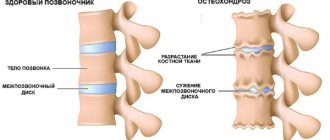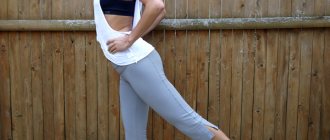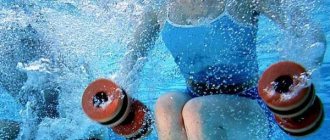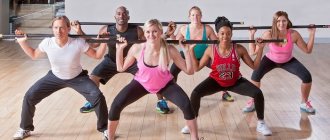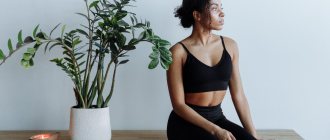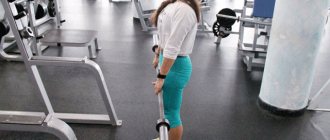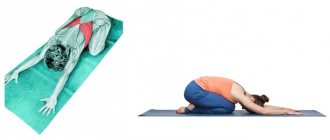A gymnastic stick is often used during fitness classes. Despite its apparent simplicity, it is possible to perform interesting exercises for various muscle groups. Due to its availability, it is widely used in gyms, as well as at home.
This sports equipment not only strengthens muscles, but also promotes weight loss.
Characteristics of a gymnastic stick
This sports equipment comes in different sizes and may also vary in weight.
Depending on your preparation and training goals, you can choose the appropriate option:
- If the workout is strength training, then it is recommended to use a bodybar . It has a metal base that is covered with rubber. The size varies from 0.9-1.2 m, weight from 1.5 to 16 kg.
- When doing gymnastics, a light stick made of plastic is suitable. It's hollow inside. The length can be 90, 120 or 150 cm.
- There are gymnastic sticks of smaller dimensions. They are suitable for training with children.
Rules for performing exercises with a gymnastic stick
Doing the exercises correctly will give you the best results and will protect you from getting injured or sprained.
There are some starting positions for different workouts:
- The gymnastic stick is in front of you. This position involves arms straightened horizontally.
- Above your head - arms straight, positioned vertically. The projectile is in the palms.
- In front of the chest is a projectile in outstretched arms. The elbows are slightly apart. The stick is located at just below shoulder level.
- The gymnastic stick can be placed behind the head, resting on the shoulders . In this position it must be held with your hands. The projectile should not put pressure on the cervical vertebrae. He goes down a little lower.
- The gymnastic apparatus is located below, at the level of the lowered arms.
Also, different types of grip can be used for different exercises:
- Straight grip (or regular). Hands are placed palms down.
- Reverse grip - palms facing up.
- There can also be a wide or narrow placement of the palms.
- In some situations, you need to hold the gymnastic stick directly by the edges. Sometimes it should be positioned vertically, resting one end on the floor.
What rules must be followed
There are several rules that must be followed when performing exercise therapy:
- if you need to hold the stick in front of you when performing this or that exercise, then your arms must be slightly bent. Do not lift the gymnastic apparatus above shoulder level, holding it not with a narrow grip, but with a wide one. If your arms are still straight, then it is advisable to hold the stick parallel to the floor;
Body bar – gymnastic stick for fitness - many exercises involve lifting a stick above your head to stretch the muscles of the back and spine . But when performing them, you also need to follow some rules, the main one of which is that your hands should be parallel to each other;
- you can hold the stick with your elbows bent , but it must be below the level of the collarbone;
- the use of a wide grip is required in cases where the gymnastic apparatus is on the shoulders . In this case, your arms should also be slightly bent at the elbows.
What does exercise therapy consist of?
By following all of the above recommendations, you can not only increase the effectiveness of your training, but also reduce the likelihood of injury.
When and how to train?
There are no special restrictions on the use of such exercises. Everyone can create a program for themselves.
But, some points should be taken into account:
- To get the maximum effect, it is advisable to train with a gymnastic stick 3-4 times weekly. Their minimum duration is 30-40 minutes.
- It is advisable to take short breaks between workouts. For example, do exercises every other day. This regime will allow the muscles to recover and will not overload the body.
- For inexperienced athletes, it is necessary to gradually reach their maximum load. To begin with, it is important to master the correct technique. During the first workouts, it is recommended to perform each exercise 10 times (1-2 approaches). Taking into account how you feel, you can increase the number of repetitions, add approaches and increase the amplitude.
It is necessary to carry out training at least 1.5-2 hours after eating . If training is carried out in the evening, then the interval between its completion and sleep should be at least 2 hours.
Sumo deadlift
The exercise effectively strengthens the back and shoulders, removes fat from the hips, and makes the buttocks denser and more toned.
Place your feet as wide as possible, with your toes turned outward. The stick is in your hands, lowered in front of you. Squeeze your shoulder blades together and lift your chin slightly, your back will bend slightly back, this deflection must be maintained throughout the entire exercise. Squat and at the same time tilt your body forward, lowering the stick to the floor. The stick moves along your legs, do not move your arms forward! When lowering the stick, do not slouch or let your chin rest on your chest. Spread your knees outward so as not to move your hands forward with the stick. Move slowly, imagine that you are pulling a heavy barbell from the floor. One approach - 20 repetitions.
Perform 2 approaches.
Photo: AiF/Eduard Kudryavitsky
What do you need to know before doing the exercises?
Before starting classes, it is recommended that you familiarize yourself with certain requirements that will help you carry out the training correctly and not harm the body:
- Be sure to warm up and warm up your joints.
- If you experience problems with the musculoskeletal system , spine, or other problems, you should consult your doctor. He must approve and approve the training program or adjust it.
- If your physical fitness is very weak or your body’s condition does not allow you to fully perform gymnastics, you can first perform several exercises without a stick so that your joints and muscles get used to it a little. Then use the gymnastic stick as provided in the health program.
Preparation for classes
Before each workout, you need to warm up and get yourself in ready shape. As a warm-up, you can perform jumping ropes or without additional equipment. Running in place can also provide an intense warm-up.
Joints and muscles also need to be warmed up by stretching, squatting and bending. Breathing exercises will help improve your breathing.
Benefits of exercise
The benefits of training with this simple equipment are undeniable:
- Allows you to load different parts of the body.
- It has a beneficial effect on the spine and trains the back.
- Improves stretching and agility.
- Tones the body and helps in the fight against excess weight.
- Symmetrically loads the muscles and promotes good coordination.
- Strengthens the muscle corset.
- Helps normalize blood circulation.
- Used in rehabilitation and recovery programs.
Exercises while standing
Lesson plan and list of exercises:
- The feet are placed at the level of the pelvis. The gymnastic stick is located behind the head. It is necessary to turn the body from side to side. The pace of the exercise is smooth and measured.
- Stand up and place your feet at a distance from each other. The gymnastic apparatus is raised up and held above the head. Tilt your torso alternately left and right. The projectile must not move from the vertical plane.
- The gymnastic stick is again located above the head. Only now the torso is tilted forward. The body from the waist to the top is straightened in a straight line. Then you need to lean back.
- Place the equipment just above the lower back, holding it with your elbows. The feet are located nearby. Take one of them to the side and pull out its toe, resting it on the floor. Tilt your torso in the same direction as your leg is pointing. Take the starting position, repeat for the other side.
- Stand up straight, spread your legs to the sides. Gymnastic stick in front of you in straight hands. Leave the position of your hands unchanged, while doing squats. In this exercise, you can change the position of your feet, leave them parallel, or turn your toes slightly outward. Lunges are performed from the same starting position.
- Place the gymnastic apparatus in height at arm's length, resting one end on the floor. Place both palms on its upper edge. The elbows do not bend. Bend your body forward with emphasis on the gymnastic stick. A slight arch forms in the back. It needs to be increased by making several springy vertical movements. Climb back up. Do the exercise again.
Exercises while sitting
- Sit down with your legs stretched out in front of you. The feet are shoulder-width apart. Place the projectile on the shoulders. Bend your body, aiming for your legs. It is necessary to spring slightly, increasing the angle of inclination. The back is straight. Take the starting position, then tilt again.
- Sitting position, legs in front of you, feet not touching. You need to turn your torso to the side and move the gymnastic apparatus upward, straightening your arms. Turn around and lower the stick. Repeat the exercise on the other side.
Exercises while lying down
In lying exercises, the legs should not bend at the knees. If you are lifting your body or legs, then at the top point you need to linger for 2-3 seconds and fix the position.
- You need to lie on your stomach. Gymnastic stick in front of you in arms outstretched forward. Legs don't touch. Raise the projectile with straight arms. At the same time, raise your head slightly. Then raise your body above the floor, bending your lower back, and place the stick on your shoulders. At the point of maximum tension, linger for 3-4 moments. Take the starting position. Run several times.
- Lie on your stomach. Gymnastic stick in hands, behind back. It is located below the pelvis. Lift your body off the floor as much as possible and look forward. At the same time, raise your arms up. Stay in this position for a while. Then return to the starting point and repeat again.
- Starting position as in the second exercise. Perform the same lift of the torso and stick. In this case, you also need to raise one leg. The knee is bent. Try to reach the gymnastics stick with the toe of this foot. Return to a lying position and repeat the exercise.
- Lie on your back. Hold the gymnastic stick in your hands, at chest level. Lift it up. Bend your knees and bring them closer to the stick, then put your feet behind the apparatus. As a result, the stick ends up behind your back. Lay it on the floor. Stretch your legs up, performing a “birch tree”. Lower your knees to your chest. Take the stick in your hands and return to the starting position in the same way. Repeat several times.
Flexibility and stretching exercises
- Stand up straight. Feet shoulder width apart. Gymnastic stick in hands, behind back. Arms straight. Place your palms with a narrow grip in the middle of the projectile. Arch your back, keeping the position of your arms unchanged. When the muscles are as tense as possible, hold for a few seconds. Then relax and repeat again.
- Starting position as in the first exercise. The grip changes, in this case it is wide (wider than the shoulders). Palms turned outward. Slowly raise your arms up. The back remains straight. Perform the exercise slowly. With its help, the rear deltas are stretched.
- Stand up straight. Gymnastic stick in front of you. Lift one edge up while lowering the other. At the maximum point, the arms are crossed. Repeat with the other side. Advanced athletes can hold their arms overhead during this exercise. To do this, flexibility must be well developed and the joints must be prepared.
- From a standing position, lift the stick with outstretched arms. Swipe over your head and bring it as far back as possible. Bring your hands back and repeat. Perform the exercise slowly, without jerking. Do not force it if discomfort or pain occurs.
- Do everything as in the previous exercise. At the moment when your hands with the stick are behind your back, you need to raise one leg and reach the stick with its toe. Then reach with your other leg. After this, return to the starting position.
Complex for weight loss
Most often, a gymnastic stick is used to strengthen the back muscles. But this sports equipment is also great for exercises aimed at burning accumulated fat. To lose excess weight, you need to exercise at a fairly active pace. The set of exercises with a gymnastic stick includes the following tasks:
- Exercise No. 1. Place your legs at a distance of about half a meter, place your hands and sports equipment behind your head, placing the stick on your shoulders. Rotate your upper body in different directions, while keeping your hips in place.
- Exercise No. 2. Do not place your feet too far apart, straighten your back. Stretch your arms holding the gymnastic stick upward. The distance between the brushes should be wide enough. Perform tilts to the right and left. This exercise allows you to effectively work your lateral abdominal muscles.
- Exercise No. 3. The feet are close, the arms with the apparatus are lowered. With your right foot, lunge in the opposite direction and extend the gymnastic stick in front of your chest. Repeat the same for the other side.
- Exercise No. 4. Your arms need to be bent. Fix the gymnastic apparatus from behind so that it is pressed against the back with the shoulder muscles. Bend in one direction, then in the other, while pointing your toe in the direction in which the movement is made.
- Exercise No. 5. Regular squats with a stick. You should not go down too deep so that your legs form a ninety-degree angle. At the same time, your arms are extended in front of you for each squat.
- Exercise No. 6. Place your feet about half a meter apart, and your arms with the gymnastic apparatus are lowered. Bend forward, but not to the floor, but to parallel with it. Press your hands with the apparatus to your chest, trying to bring your shoulder blades together.
- Exercise No. 7. Place the gymnastic stick on one end directly in front of you. Lean on it with both palms, spread your legs wider. Bend over, arching your back. Start making small rocking movements. Repeat several times, try to increase the deflection.
- Exercise No. 8. You need to sit down on one knee, the other leg remains straight. Bend your arms at the elbows, placing the stick on your shoulders. Move the leg that is straight to the side, simultaneously bending towards it. Then change the knee and repeat the same for the second limb.
- Exercise No. 9. Performed from a sitting position. It is necessary to spread your straight legs as wide as possible. The arms are bent, the projectile is located on the shoulders. Bend forward, trying to bend your back as much as possible. You need to spring a little so that the muscles stretch gradually.
Some of the exercises with a gymnastic stick
Exercises with a gymnastic stick for osteochondrosis
This set of exercises is therapeutic in nature, and not just recreational. People with a sedentary lifestyle are susceptible to osteochondrosis. In this mode, muscles gradually lose their elasticity.
The following exercises will help in the fight against this disease:
- Stand straight. Gymnastic stick in front of you. You need to hold it by the edges. From this position, turn your torso in different directions. Do not change the position of your hands throughout the execution.
- The position of the first exercise remains unchanged. It is necessary to raise your hands together with the stick above your head and return them back. Do not bend your elbows.
- Do the second exercise. At the same time, monitor your breathing. Inhale as you raise your arms, exhale as you lower them. Breathing is deep and measured.
- Stand up straight. Hands hold a gymnastic stick above your head. It is necessary to inhale and at the same time tilt the body forward. The lower back bends. You need to touch the floor with the stick. Then straighten back up, exhaling.
These 4 exercises are considered basic. They can be performed not only for treatment, but also as prevention.
Important: This set of exercises is prescribed by your attending physician. It takes into account which area of the spine suffers from the disease and calculates the norm of permissible loads.
Starting your workout
Experienced athletes know that it is impossible to jump up and immediately begin performing any exercise, since this can lead to serious consequences. In such cases, a clear sequence is required. The optimal time for gymnastics is early in the morning, since during morning workouts it is easier to tone the back muscles. In addition, the body will be able to receive a greater charge of energy, which is necessary to carry out normal activities. It is strictly not recommended to exercise on a full stomach, so training should begin approximately 40-60 minutes before meals.
Exercises with a gymnastic stick
On a note! If it is not possible to conduct morning training, then you can choose a more suitable time for training. But you also need to choose it correctly for exercise: 1 hour before and after meals, and also 2 hours before going to bed.
Warm-up
All types of training should begin with a warm-up, as the body needs to warm up well before further physical activity. The warm-up complex includes:
- jumping rope – 5-7 minutes;
- squats – 15 times;
- running in place (no more than 7 minutes);
- gentle stretching of all muscle groups, starting with the legs and ending with the neck muscles;
- light warm-up of the lower and upper limbs.
Warm-up before exercise is required
As noted earlier, all elements of exercise therapy should be accompanied by a gradual increase in the load on the body . That is, the number of approaches and repetitions should increase at a slow pace so that the muscle tissue can get used to a certain load. Also, to achieve a greater effect from training when performing different exercises, you need to independently strain and control the work of the muscle group being worked.
Set of exercises
When performing the exercises given below, you must be guided by the following rules: from a standing position, your feet should be placed shoulder-width apart, all movements should be performed while exhaling, and the number of repetitions in each exercise should be at least 6 times.
Table. Gymnastics for the back with a gymnastic stick.
| Exercise, photo | Description |
| №1 | Standing position, place your feet wider than your shoulders and lift the stick above your head. The grip should be wide. Slowly rotate your arms in a horizontal plane without releasing the gymnastic stick. After crossing completely, return your arms to the starting position. |
| №2 | Keeping your legs straight, tilt your body forward and rest your hands on the stick, which should be perpendicular to the floor. Your arms should also be straight. Gently rock up and down. |
| №3 | Place the stick vertically in front of you. Hold it with your hand and swing your foot over the stick, first one way and then the other. After 6-7 repetitions, change legs. |
| №4 | Lie on your back and, leaning on a stick in a scapular stance, lift your legs up. Then tilt your torso back and forth without lifting the gymnastic stick from the floor surface. |
| №5 | Take the stick with a wide grip and lift it above your head. Do alternating lunges, moving the stick back as far as possible, thereby bending your body. |
| №6 | Raise the stick up above your head using a medium grip. Keeping your back straight, gently bend at the waist and return to the starting position. |
| №7 | Place your feet shoulder-width apart, pointing your toes apart, and place the stick behind your back at the level of your shoulder blades. The gymnastic apparatus must be held with a wide grip. Perform the “mill” exercise - turn your torso to the sides and bend at the same time. |
Provided that all exercises with a gymnastic stick are performed correctly, you can not only strengthen the spine and muscle corset, but also prevent various diseases of the spine, including osteochondrosis, radiculopathy, intervertebral hernia, foraminal stenosis and others. Also, with the help of exercise therapy, you can get rid of a couple of extra pounds.
Do all the exercises correctly
Exercises with a stick and expander
- The gymnastic stick is on the shoulders. The edges of the expander are attached to its edges. Feet shoulder-width apart, feet holding the middle of the expander on the floor. From this position, perform squats.
- Get on all fours with emphasis on your palms. The stick is held in the hands. The expander takes the form of a loop, the middle of which is hooked to the heels, and the edges are held on a stick. Swing your leg back and up, overcoming the resistance of the expander. Perform the exercise alternately for each leg.
- Perform deadlifts. Instead of a barbell, he holds a gymnastic stick in his hands. The expander is held by the feet. When lifted up, it stretches, providing resistance.
- Perform squats as in the first exercise. In a straightened position, you need to lift the gymnastic stick up above your head. At the same time, the expander stretches even more and provides greater resistance.
In addition to the expander, you can also use a fitball for exercise.
Types of training
Body rotations. In this exercise, the gymnastic stick should be on the shoulders and the arms should be bent. In this position, you need to make smooth turns to the right and left alternately. With each new approach, increase the number of turns.
Body tilts. The stick is also on the shoulders, and the arms are bent. In such a stance, you should bend in different directions. With this type of exercise, the neck muscles should not be tensed, because they interfere with the work of other muscle groups.
There is a second type of this exercise, but with a different grip of the gymnastic stick. It is located vertically. Use a wide hand grip. The tilts are repeated according to the old pattern to the right, then to the left.Body tilts forward. You need to stand up straight and tilt your body as far as possible. His muscles are tense and his chin is pointed straight. Then the body leans back, but the back does not arch.
Exercises while lying on your stomach. The starting position is lying down, the stick is extended forward. Your arms need to be raised as high as possible. The head is raised, and the projectile is moved to the shoulders. This position is maintained for a very long time.
A set of exercises for gaining weight - basic exercises and recommendations for selecting weights for exercisesWe perform squats with dumbbells - a description of the technique of performing the exercise. Subtleties and secrets of squats for girls (125 photos)
The best dumbbell press - advice from professionals and basic variations of the basic exercise (75 photos)
Exercises while lying on your back. The arms should be straight, the projectile should be held, as before, with a wide grip. The legs must be pulled up to the chest and bent at the knees, and the stick is passed under the buttocks to the floor. Legs straighten up, toes stretch. After this, your legs should be lowered. Then this is all repeated backwards.
Lunges and squats. One of the legs is fixed in place, and the other should be pushed forward as far as possible. The gymnastic stick lies on the shoulders, the back should not be subject to arching.
In this position, several squats are performed. After this, the leg that was exposed is moved back. Squats are performed again. For greater effectiveness, the legs should be changed.
Photos and videos of the corresponding exercises can be found on the Internet and performed based on this material. The first results of training will be noticeable within a couple of weeks.
For osteochondrosis, which is observed in office workers, drivers or students, training with gymnastic sticks will be most effective. Moreover, such preventive exercises do not require professional skills or expensive equipment. However, all training must be coordinated with a doctor so that he warns about all possible consequences. Once you start training, you shouldn’t abandon it, and most importantly, don’t be lazy.
Exercises with a gymnastic stick for children
General developmental exercise therapy exercises with a gymnastic stick are useful for both adults and children of any age: small children, preschoolers and schoolchildren. Many preschool institutions conduct lessons with a gymnastic stick.
- Starting position standing. Gymnastic stick in lowered hands. Raise it in front of you. Then overhead. Again in front of you and lower down. While performing this exercise, the child can linger for a few seconds at each stage.
- Stand straight, feet together. Hold the stick down with a wide grip. Rise onto your toes and at the same time lift the projectile above your head. Stay a little longer. Return to starting position. Keep your heels together while performing. The gaze is directed at the stick at the highest point, above the head.
- From a standing position, raise the stick in front of you. Take one leg back. Raise the stick up without taking your eyes off it. Return to starting position and repeat on the other side. The working leg is pulled back without bending the knee, the toe is turned outward.
- Take a sitting position. Gymnastic stick in front of you in straight hands. Draw circles in the air first with one end of the stick, then with the other.
- Stand on one leg. The projectile is in a vertical position. One side rests on the floor, hold the other side with the opposite hand. Leaning on a stick, jump on one leg around it. Having described one circle, change sides while jumping and stand on the other leg. Repeat jumping on the second leg.
The benefits of such exercises
In some cases, exercise therapy is much more beneficial than drug treatment. You just need to follow certain rules - do not ignore doctors’ recommendations, do not self-medicate, and always seek help from a qualified specialist to conduct a diagnostic examination and draw up a training plan. Correct and regular performance of a set of exercises with a gymnastic stick promotes the regeneration of affected tissues and restoration of spinal functions if they have been impaired in any way. Exercise therapy is also effective for preventive purposes, since when performing gymnastic exercises in the back area, blood circulation improves.
Prices for posture trainers
What muscles are used during exercise?
The main benefits of back exercises with a gymnastic stick include:
- boosting the immune system;
- restoration of the functioning of internal organs;
- improved posture;
- normalization of blood circulation in the back and throughout the body;
- strengthening all parts of the spine;
- increased muscle tone in the back area.
If you want to learn in more detail how to strengthen your back muscles at home, and also consider effective methods, you can read an article about this on our portal.
Exercises with a stick strengthen your back muscles
Note! When treating various diseases of the spine with the help of exercise therapy, it is necessary to first eliminate the pain syndrome. For this purpose, various ointments or painkillers can be used. Only after the pain has been eliminated can you begin training. Otherwise, discomfort and back pain will not allow you to achieve the maximum therapeutic effect.
Exercises for the elderly
It is never too late to start exercising for older people, both for the general condition of the body and for posture.
List of exercises:
- In a standing position, hold the gymnastic apparatus in your lowered hands. Feet together. Raise the projectile up, lower your head. Take the starting position. Repeat the exercise.
- Feet shoulder width apart. Gymnastic stick in straight hands above your head. The grip is wide. Perform body tilts alternately in different directions.
- Starting position as in the second exercise. Instead of bending, turn your body in different directions.
Seated presses
Exercise for the chest, arms and shoulders, including the abdominal muscles.
Sit on a chair or armchair, lean back (you cannot sit without support under your lower back). Look ahead and slightly up. The stick is pressed to the chest from above, the arms are bent and pressed to the body, the elbows are back. Straighten your arms forward in front of your chest, return them to their starting position. Straighten it up above you (you can lean back slightly and tilt your head), return to the starting position again. One approach - 20 such cycles.
Perform 2-3 approaches.
Photo: AiF/Eduard Kudryavitsky
Exercises in pairs
In order to work in pairs, you need to choose a partner who is suitable in terms of physical parameters. There shouldn't be too much difference in weight. It is desirable that the partners be of the same gender and with the same level of training.
Attention : All exercises that involve resistance must be performed taking into account the physical strength and capabilities of the partner. The exercise should not take on a competitive nature.
- Partners stand facing each other. Gymnastic sticks are held in the hands at chest level. Each of them tries to push the right end of the stick forward, while at the same time holding resistance with his left hand.
- Take a sitting position facing each other. Pull the gymnastic stick, holding it by the ends. You can perform this exercise with your feet shoulder-width apart. Or you can connect them together.
- Stand with a friend opposite the arch. Gymnastic sticks on the bottom sides. Each of them is held at different ends by both partners. Raise one stick sideways, the other up. Then change movements for the other side.
Exercises for arms, neck, posture and legs
- One of the simplest general exercises is to jump over a stick on the floor in one direction, then in the opposite direction.
- Place the stick vertically in front of you. Place both hands on the top. From this position, perform squats and return to the starting position.
- Stick in hands below, feet shoulder-width apart. Lunge forward. Raise the stick above your head and move your arms back, arching your back as much as possible. Return to the starting position and repeat for the other leg.
- Hold the gymnastic apparatus in front of you. Place your hands behind your head without bending them. Slowly move the stick in your hands in one direction, then in the other. The neck should not turn.
Exercises for lumbar and thoracic osteochondrosis
Currently, many sets of physical exercises have been developed for osteochondrosis. They differ in duration, intensity, direction of impact, stage of the disease and level of load. Exercises for lumbar and thoracic osteochondrosis include exercises that can be performed both standing and lying down. It depends on the condition of the patient's muscles.
At the initial stage, in order to avoid discomfort, it is better to perform exercises while lying on the floor, on a special gymnastic mat. A specialist will help you choose a complex that combines movements of increasing complexity.
Exercises are common and effective for spinal osteochondrosis. To begin, you should take the starting position: stand with your feet shoulder-width apart, parallel to each other. The gymnastic stick should be taken so that the distance between the hands is no wider than the shoulders.
Next, perform the following exercises:
- Turn the steering wheel: circular movements of the hands are performed left and right.
- Head turns.
- Inhale, stick up, lower, exhale.
- Bring it to your neck (elbows parallel to the floor), lower your chin, pull the stick forward, tilt your head back.
- Grab your neck with a stick, turn your shoulders to the right and left, return to the starting position.
- Raise your outstretched arms above your head, inhale, bend your knees, exhale, straighten your arms in front of your chest.
- Bend your right arm at the elbow, extend it upward, and turn your head to the left. When bending your left arm, your head should be turned to the right.
- Bend your elbows, holding a stick behind your back. Rotate your upper body left and right without pausing.
At the end of the complex, you should perform squats, raising the stick to chest level.
All exercises are performed at a slow pace, observing breathing, 5-7 times.
Recommendations
Some recommendations will help make training comfortable and effective:
- If pain or discomfort occurs during exercise, you should temporarily stop training and consult a specialist.
- The room must be well ventilated so that the air is saturated with oxygen. The air temperature should not be too high.
- You need to perform movements smoothly and carefully until the correct technique is mastered.
- It is necessary to use comfortable clothes for training , which will not interfere with working at full amplitude and will not hinder movement.
Experts believe that exercise therapy and exercises with a gymnastic stick are considered a priority treatment method for scoliosis. Exercises with a stick strengthen various muscle groups. Gymnastics with a stick will ensure a slim body, prevent osteochondrosis, and also help you quickly lose a few extra pounds.
Alexandrova Anastasia
Nutrition and healthy lifestyle specialist and author of myfitnesblog.com. For many years, she has successfully helped women and men lose weight and maintain a beautiful figure.
How to choose the right projectile
For exercises with a weight loss stick to be beneficial, you need to choose the right equipment. Modern stores of special training equipment offer a large selection of them. There are several types of sticks:
- Classic. This projectile is the simplest and most common. Even children can train with it, which is why it is often used in schools. It can be made of different materials, such as plastic or wood.
- Weighted. Typically used for strength or cardio training. It is made of metal, which increases the weight of the projectile.
- With shock absorber. Most often used in physical therapy, but can also be used in aerobics. In addition to working out muscles, it helps improve coordination.
- With an expander. Special loops are attached to the gymnastic apparatus itself, which must be put on the feet. Allows you to better work out various muscle groups and is often used in fitness.
- Flexible. This gymnastic stick is made from softer and transformable materials. Allows you to develop flexibility of various muscle groups and promotes stretching.
Gymnastic stick with expander
A gymnastic stick for weight loss must be chosen based on what type of load is planned. For beginners in sports and those who purchase equipment for weight loss, the most common and light-weight option, without any additional functions, is well suited. And for more “advanced” athletes, the ideal choice is a weighted stick or with an expander.
It is also important to consider the length of the inventory. Short people should not choose a stick that is too long. But for athletes who have the parameters of a basketball player, a short projectile is definitely not suitable.
Watch the video about exercises with a gymnastic stick:
